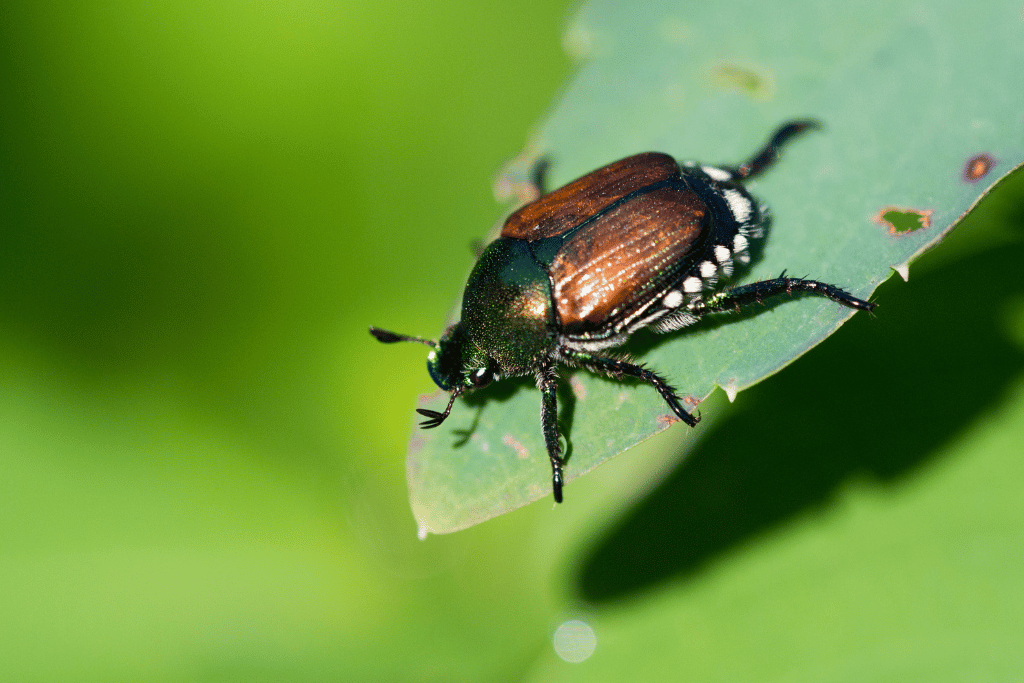I have an intense obsession when it comes to discovering new flower species. In fact, it won’t be wrong to say that I am always on a mission to explore the vast and diverse world of flowers. It’s truly astounding how nature has blessed us with an abundance of flower species, each with its own unique color and shape.
My current endeavor has led me to start an exciting project where I’m gathering information on as many flowers as possible, aiming to create a comprehensive catalog of these natural wonders. And what better place to start than with flowers that begin with the letter “C”?
This article on Flowers that start with C will be a delightful journey through the captivating world of “C” flowers. Along with the names of these exquisite blooms, I’ll be featuring stunning images that showcase their beauty in all its glory. From classic favorites like carnations and chrysanthemums to lesser-known gems like calibrachoas and celosias, I’ll leave no petal unturned in my quest to present a diverse array of “C” flowers.
So, if you’re as fascinated by the world of colors and shapes that flowers offer, I invite you to read further.
20 Flowers That Start With C
1. Carnations – Everlasting Elegance

Carnations, with their exquisite ruffled petals and enchanting fragrance, have captured the hearts of flower enthusiasts worldwide. These enduring blooms come in a myriad of colors, each carrying its unique symbolism. Often associated with love, admiration, and distinction, Carnations have become a favorite choice for expressing sentiments on various occasions, from Mother’s Day to weddings and even funerals.
Beyond their aesthetic appeal, Carnations have found their way into culinary explorations, garnishing desserts and drinks with their delicate petals. Additionally, these lovely flowers have been employed for their therapeutic properties, with extracts used in traditional medicine to ease stress and promote relaxation. Embodying beauty and timeless elegance, Carnations stand as a symbol of love’s enduring power.
2. Chrysanthemums – Emblems of Enduring Beauty
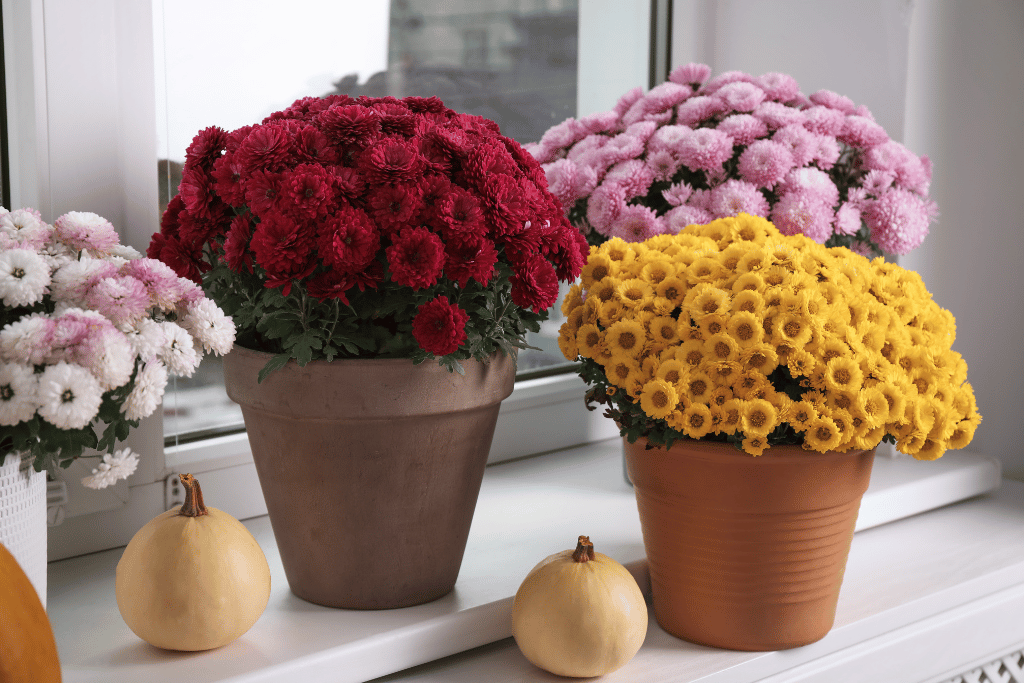
Chrysanthemums, also known as mums, are celebrated for their stunning array of colors and petal arrangements, exuding grace and elegance. Revered for centuries, these blooms symbolize enduring beauty and have found their way into various cultural significances.
In Japan, Chrysanthemums hold a special place as the Imperial Family’s crest, signifying longevity and rejuvenation. Meanwhile, in China, these blossoms have been cherished for millennia, representing nobility and purity. The diverse symbolism of Chrysanthemums makes them a preferred choice for joyful celebrations, solemn memorials, and everything in between. As you admire the timeless allure of Chrysanthemums, you can’t help but appreciate the profound connection between nature’s creations and our deepest emotions.
3. Calla Lilies – Elegance in Simplicity
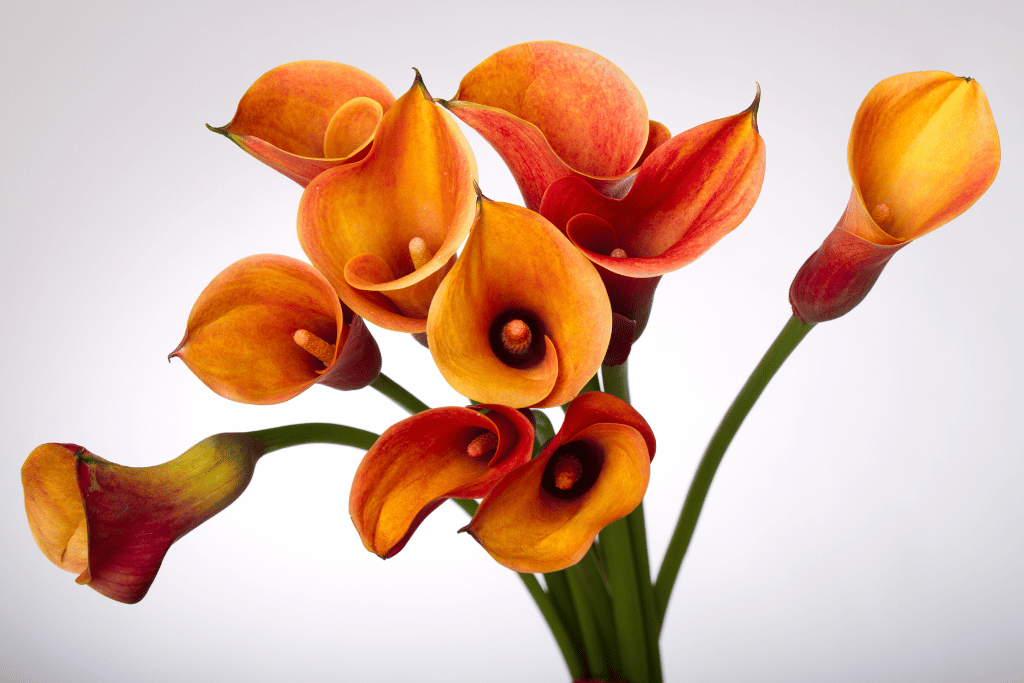
Calla Lilies, with their elegant simplicity and trumpet-shaped blooms, stand as timeless symbols of purity, faith, and rebirth. Originating from the Greek word “calla,” meaning beauty, these lilies possess a delicate charm that captivates hearts worldwide.These enchanting flowers have inspired numerous artists with their graceful form and soft hues, finding their place in the world of art and literature. As you witness the allure of Calla Lilies, you’ll be reminded of the beauty found in simplicity and the profound emotions they evoke.
Associated with various deities and myths, Calla Lilies hold immense significance. In Christian beliefs, they symbolize Jesus’ resurrection, evoking sentiments of faith and devotion. Moreover, their association with weddings signifies marital bliss and fidelity, making them a popular choice for bridal bouquets.
4. Canna Lilies – Tropical Allure

Canna Lilies, often referred to simply as Cannas, boast a tropical allure with their large, vibrant blooms and lush foliage. Available in a wide range of colors, from fiery reds to sunny yellows and rich oranges, Canna Lilies create a striking visual impact.
They are native to tropical and subtropical regions, these showy flowers have become popular ornamental plants in gardens worldwide. Not only admired for their flowers, but the broad and colorful leaves also add a touch of drama to any landscape. With their love for warm weather and ample sunlight, Cannas thrive in summer gardens, adding a touch of exotic beauty. These hardy plants are sure to impress with their bold and vibrant display, making them a favorite choice for gardeners seeking a taste of the tropics.
5. Cosmos – Dainty and Delightful

Cosmos have a carefree and natural appearance, lending an effortless beauty to any space. Whether swaying gently in the breeze or adorning bouquets, these lovely flowers never fail to bring joy and a sense of playfulness to those who encounter them.
Available in a delightful range of colors, including pink, white, and various shades of red and purple, Cosmos create a vibrant and enchanting display. They attract butterflies, bees, and other pollinators, making them an excellent choice for wildlife-friendly gardens. Cosmos, with their dainty, daisy-like flowers and feathery foliage, bring an air of delicacy to any garden or landscape. Native to Mexico, these charming annual flowers have found popularity around the world due to their easy cultivation and profuse blooming.
6. Crocuses – Awakeners of Spring

Crocuses are the heralds of spring, emerging from the cold earth to paint the landscape with their delicate petals and vibrant colors. These petite flowers bring a sense of hope and renewal, signaling the end of winter’s slumber and the beginning of nature’s reawakening. Crocuses come in various shades of purple, white, yellow, and even striped varieties, adding a splash of beauty to gardens, parks, and meadows.
These ephemeral blooms hold deep symbolism across cultures, representing youthfulness, spiritual growth, and resilience. As they bloom amidst adversity, Crocuses remind us of the cyclical nature of life and the promise of new beginnings even after the darkest days. Their appearance is a delightful reminder of the beauty and joy that spring brings after a long, cold season.
7. Camellias – Queens of Winter

Camellias come in various species and cultivars, each displaying a unique array of colors, including shades of pink, red, white, and even variegated patterns. Their elegant presence and association with love and admiration have made them popular choices for romantic gestures and wedding ceremonies. In addition to their ornamental value, certain species of Camellias are cultivated for their tea leaves, contributing to the world-famous beverage’s distinct flavor. With their regal beauty and cultural significance, Camellias continue to reign as one of the most beloved ornamental flowers.
They are often referred to as the “queens of winter,” enchant with their luxurious blooms and glossy evergreen foliage. Native to Asia, these stunning flowers have captivated hearts for centuries, gracing gardens, landscapes, and traditional tea ceremonies.
8. Cymbidium Orchids – Majestic Beauties

Symbolizing love, beauty, and refinement, these elegant orchids add an aura of sophistication to any setting, leaving admirers in awe of nature’s intricacy. Cymbidium Orchids, also known as “boat orchids,” are renowned for their striking and intricate blooms, making them highly sought-after ornamental plants.
These flowers start with C, native to Southeast Asia and the Himalayas, these orchids have become popular additions to gardens and indoor spaces worldwide. With their long, arching spikes and a wide range of colors, including white, pink, yellow, and green, Cymbidium Orchids create a captivating display. They are cherished for their longevity as cut flowers and their ability to thrive in various climates, making them accessible to orchid enthusiasts of all skill levels.
9. Coneflowers – Nature’s Pollinator Magnets

Coneflowers are available in various colors, including shades of purple, pink, white, and orange, bringing a vibrant and cheerful ambiance to outdoor spaces. Apart from their ornamental appeal, certain species of Echinacea are also used in herbal medicine for their potential immune-boosting properties. With their long-lasting blooms and ecological significance, Coneflowers have secured their place as not only beautiful ornamental plants but also valuable contributors to biodiversity.
Coneflowers, also known as Echinacea, are beloved for their tough and resilient nature, as well as their charming daisy-like blooms with prominent, cone-shaped centers. Native to North America, these hardy perennials have become popular choices for pollinator-friendly gardens, attracting butterflies, bees, and other beneficial insects.
10. Cornflowers – Captivating Blues

Cornflowers, also known as “bachelor’s buttons,” are delightful annual flowers adored for their bright blue, pink, white, and purple blooms. They are native to Europe, these charming flowers have naturalized in various regions, making them a welcome sight in meadows, gardens, and along roadways. Cornflowers hold historical significance, having been used as traditional medicinal herbs and symbolic tokens of love and fidelity in folklore.
These easy-to-grow plants are excellent for attracting bees and other pollinators, contributing to the health and biodiversity of the ecosystem. Their enchanting and simple beauty makes them popular choices for wildflower gardens and informal floral arrangements, adding a touch of nostalgia and country charm to any setting.
11. Calendula – Cheerful Pot Marigolds

Calendula is renowned for its soothing and healing properties, making it a popular ingredient in salves, creams, and herbal remedies for skin conditions. In the garden, these hardy plants are known for their ability to attract beneficial insects and deter harmful pests, making them valuable additions to organic gardening practices. The cheerful and radiant appearance of Calendula brings a warm and inviting atmosphere to any landscape, reminding us of the beauty and practicality of nature’s offerings.
It is commonly known as “pot marigold,” a cheerful and vibrant annual or perennial flower cherished for its bright yellow and orange blooms. It originated in southern Europe. These sunny flowers have naturalized in various regions and have a long history of medicinal and culinary uses.
12. Cyclamen – Graceful Winter Blooms

Cyclamen is a genus of charming and graceful flowering plants, treasured for their delicate, upswept petals and marbled foliage. These tuberous perennials are native to Mediterranean regions and are known for their ability to bloom even in the coldest months, adding a touch of elegance to winter gardens.
Cyclamen flowers come in various colors, including shades of pink, white, and purple, with each variety possessing its unique charm. Their captivating appearance has inspired many artists and artisans, with Cyclamen motifs found in pottery, paintings, and decorative arts throughout history. These enchanting blooms are often associated with love and sincere affection, making them meaningful gifts for special occasions or as a token of appreciation for loved ones.
13. Celosia – Flamboyant and Unique

These velvety nature flowers that start with the letter C, native to tropical regions, Celosia thrives in warm climates, producing velvety, feathery, or crested flower heads in red, orange, yellow, and pink shades. Also known as “cockscomb” due to its striking resemblance to a rooster’s comb, is a group of eye-catching annual flowers prized for their unique appearance and vibrant colors. The distinctive appearance of Celosia makes it a favorite choice for adding drama and texture to gardens, floral arrangements, and even culinary garnishes.
Celosia holds symbolic significance, representing immortality and long-lasting love in some cultures. With their exuberant and flamboyant nature, Celosia blooms ignite a sense of joy and excitement, making them a must-have for those seeking to create bold and eye-catching floral displays.
14. Coral Bells – Colorful Foliage Stars

Coral Bells, part of the Heuchera genus, are cherished for their ornamental foliage and dainty, bell-shaped flowers. These versatile perennials come in a wide array of foliage colors, ranging from vibrant green to deep burgundy, silver, and even variegated patterns. The stunning foliage is often the main attraction of Coral Bells, with their flowers providing an additional burst of charm during the blooming season.
Native to North America, these plants are excellent choices for adding texture and color to shade gardens or mixed borders. With their tolerance to various growing conditions and their ability to attract hummingbirds and butterflies, Coral Bells have become popular choices for adding life and vibrancy to outdoor spaces.
15. Coleus – Foliage Wonders

Coleus plants are easy to grow, making them popular choices for container gardens, borders, and indoor displays. They thrive in partial shade, and their vibrant foliage adds a much-needed pop of color to shady areas in the garden. With their impressive diversity and eye-catching appearance, Coleus plants continue to be a favorite among gardeners seeking foliage-focused ornamental plants.
Coleus, also known as “painted nettle” or “flame nettle,” are beloved for their striking and colorful foliage patterns rather than their flowers. Native to Southeast Asia, these tropical perennials are valued for their unique leaves, which come in a wide range of shapes and hues, including bold stripes, splashes, and combinations of green, red, pink, yellow, and purple.
16. Cineraria – Velvety Petals

Cineraria comes in a variety of striking colors, including shades of blue, pink, purple, and white. Cineraria thrive in cool temperatures, making them excellent choices for winter and early spring gardens. With proper care, Cineraria can bloom profusely, creating a spectacular show of colors. Their unique daisy-like flowers add a touch of elegance to any setting, and their rich hues evoke a sense of joy and happiness, brightening up even the dullest days.
They are also known as “Pericallis,” a stunning annual or biennial flower renowned for its vibrant and velvety blooms. Cinerarias are native to the Canary Islands, and these colorful flowers are commonly grown as indoor or outdoor ornamental plants, gracing gardens, and floral displays with their cheerful appearance.
17. Clarkia – Farewell to Spring

Clarkia flowers come in shades of pink, red, and purple, and they possess an understated grace that captivates nature lovers. Clarkia, often referred to as “farewell to spring,” is a charming annual flower native to western North America. These delicate blooms are cherished for their simplicity and beauty, adorning fields, meadows, and gardens with their airy appearance.
Their papery petals flutter in the breeze, resembling a delicate dance that seems to bid farewell to the passing spring. Clarkias are easy to grow from seed, making them popular choices for wildflower gardens and naturalistic landscapes. With their gentle charm and effortless beauty, Clarkia flowers remind us of the fleeting yet precious moments that spring offers, encouraging us to cherish nature’s gifts.
18. Canterbury Bells – Bell-Shaped Elegance
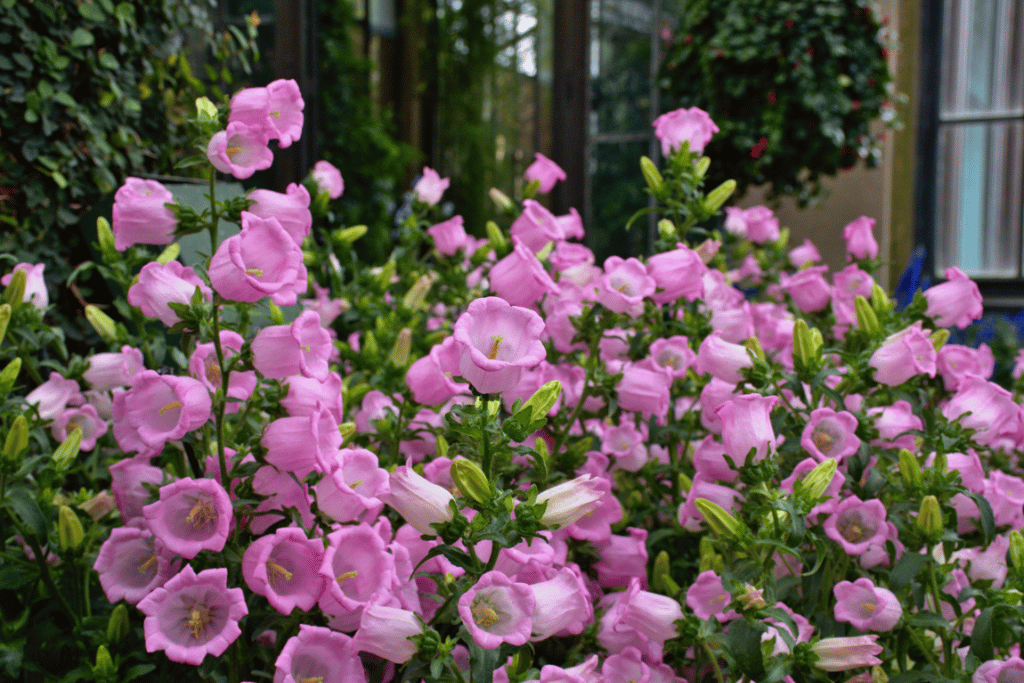
The name “Canterbury Bells” originates from their resemblance to the bells hanging in the archways of Canterbury Cathedral, further adding to their allure and historical significance. Canterbury Bells, also referred as “cup and saucer” plants, are enchanting biennial or perennial flowers hailing from southern Europe. These bell-shaped blooms, available in various shades of blue, purple, pink, and white, are revered for their elegant and classic charm.
Canterbury Bells grow on tall, upright stalks, creating a striking vertical display in gardens and borders. Their enchanting form and delicate hues have made them a favorite choice for cottage gardens and traditional flower arrangements. As a biennial, they bloom in the second year of growth, rewarding patient gardeners with their exquisite flowers.
19. Chinese Lanterns – Autumn’s Glow

Chinese Lanterns add an autumnal touch to gardens and floral arrangements, making them popular choices for fall displays. Chinese Lanterns, also known as “winter cherry” or “bladder cherry,” are captivating ornamental plants loved for their distinctive, papery, orange-red husks that enclose their fruit. Native to regions of Asia, these perennial plants provide an intriguing visual appeal with their lantern-like calyxes, which persist even after the flowers have faded.
The fruit inside the lanterns is not edible, but the husks can be used in dried flower arrangements and crafts. With their unique appearance and long-lasting appeal, Chinese Lanterns create an aura of mystery and fascination, reminding us of the beauty and wonder found in the natural world.
20. Crown of Thorns – Resilient Beauty
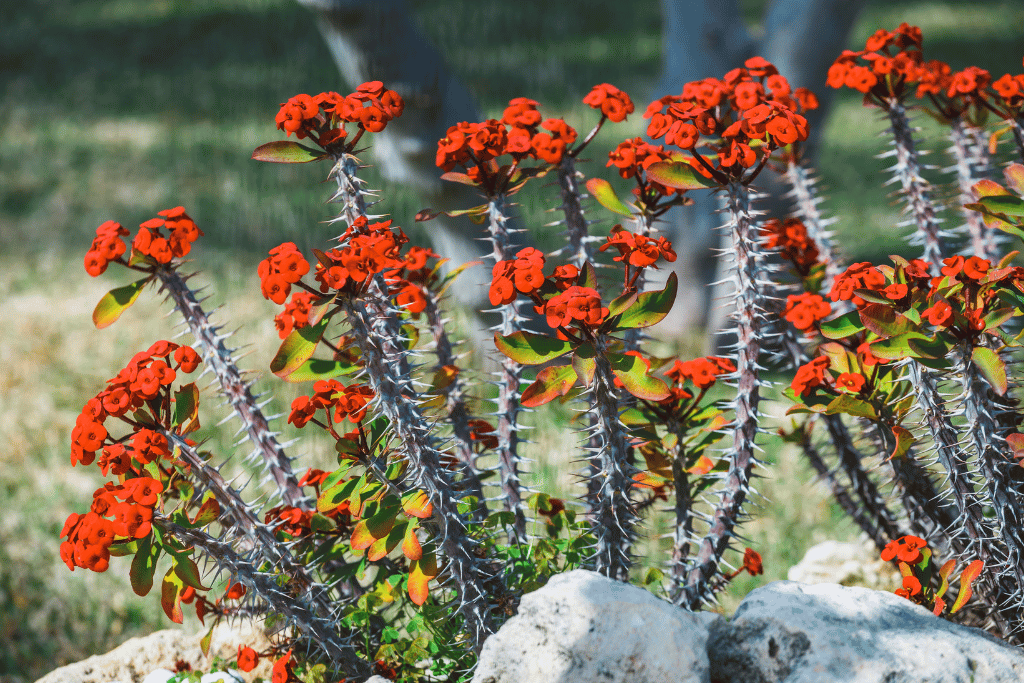
Crown of Thorns is a captivating succulent known for its spiky stems and colorful clusters of small, showy flowers. Native to Madagascar, this drought-tolerant plant is popular in arid and tropical gardens, as well as indoor settings. The name “Crown of Thorns” refers to the legend that it was used as the crown of thorns placed on Jesus’ head during the crucifixion.
The plant is highly symbolic, representing sacrifice and enduring love. Despite its thorny appearance, Crown of Thorns rewards gardeners with its stunning display of flowers in shades of red, pink, orange, and white. With their resilience and beauty, these succulents remind us of the strength and tenacity required to thrive in challenging environments, making them a cherished addition to any plant collection.


